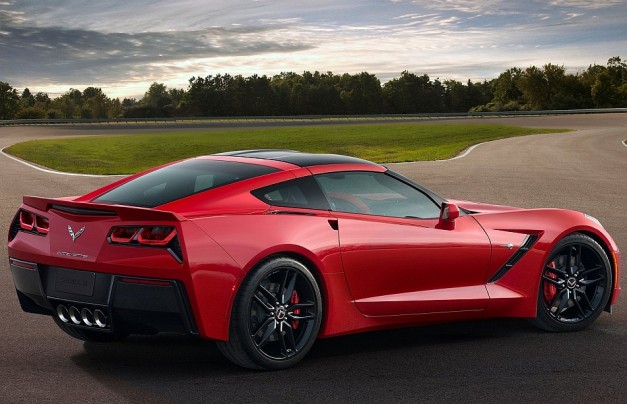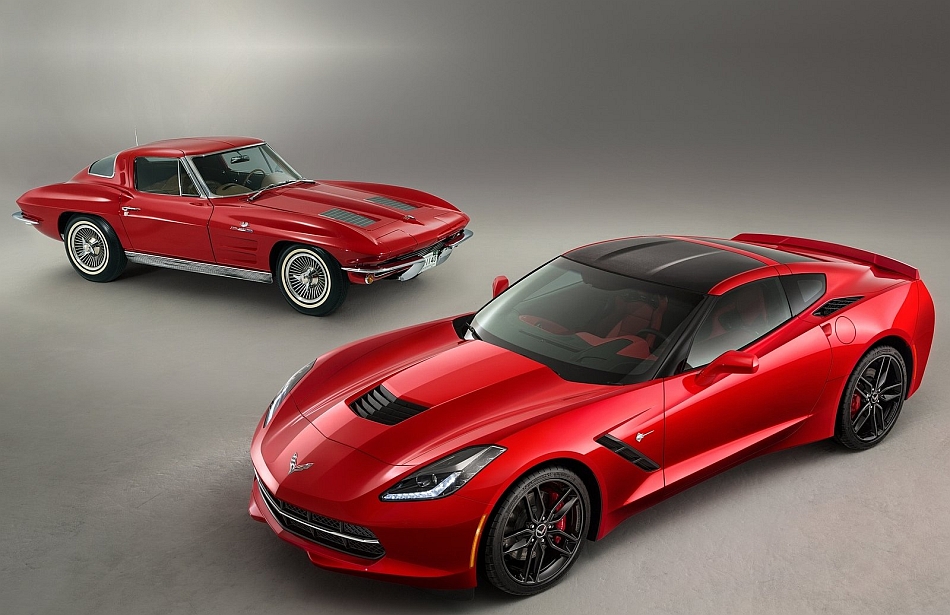
For the last two years or so it seemed that every day a detail about the C7 Corvette would be "revealed," a spy photo taken of a C6 testing C7 hardware, or a new computer rendering drawn up for the sake of causing internet debates long enough to seemingly outlive the Corvette's 60-year history. But when the curtains were drawn, the smoke cleared, and the official vehicle rolled onto the stage before the press at the Detroit Auto Show, the only words that could be uttered were those of awe, shock, and slight confusion. After years of anticipation, it took just moments for the actual C7 to spark great controversy and simultaneously put the entire automotive industry on notice.
For generations the Corvette was the poster child of the affordable American sports car. Powerful, light-weight, and accessible to the average working man, the 'Vette was the icon you grew up dreaming about, the sports car you worked day-in and day-out to afford, and the investment you made when your kids were finally out of the house. But those stereotypes began to vanish with the C5 when Chevrolet introduced the Z06, an even higher-performance, more track-oriented model, and by the time the C6 Z06 and the world-crushing ZR1 came around the Corvette was no longer "go-to" car for the 50 year-old male going through his mid-life crisis; no, the Corvette was the epitome of world-class, near-supercar performance at a price you would never expect. Even the base C6 was capable of low 4-second 0-60 times, top speeds approaching the magic 200 MPH mark, and handling abilities that were on par with the Germans and Italians. Introduce the C7 and those performance standards have been raised even higher. But GM easily could have left it at that; instead, they employed their most talented and creative designers to create the C7 as not only a new Corvette, but as a vehicle that will represent the brand, stand out in even a crowd of Italian supercars, and truly be the image of the American Revolution they were looking for in their 2004 ad campaign.


To put it simply, the C7 is unlike any Corvette we have ever seen before. Sure, there are similarities to the C6 (especially one of the wheel options, which looks like a carryover from the previous generation), but the details go so much further. And although it is a Corvette in spirit, motor and heart, it truly does take design cues from many other vehicles on the road today -- and that is by no means a bad thing.
Look at the front end of the C7 and you get eyes full of C6 Vette and an equal amount of Viper. The open grille looks like it was pulled directly from the two cars, with the engineers having their say and allowing the opening to suck in as much air as possible. It's not a drastic change from the C6, but there is an undeniable resemblance to the snake-bitten V10-bearing supercar built by Chevy's American rivals. Meanwhile, the hood is vaguely reminiscent of the C6 ZR1's window-style setup, featuring louvers in place of the see-through section, with intent on keeping the engine cooler (more emphasis on performance is never a bad thing for a Corvette) and a contoured look that is more shapely and detailed than before. The headlights, which are a big change from the C6's, look as if they were just slightly modified after being pulled from a Ferrari 458. Influences from the SRT Viper, Ferrari 458, and the company's own ZR1 in the front end alone? Not a bad place to start by any means.
On a related note, here's a fun story about the Corvette and the Viper: when Dodge (now SRT) ended production of the 4th Generation Viper in 2010, outrage and sadness echoed through the crowd of enthusiasts who loved the car for its raw power, lack of electronic nannies like traction and stability control, and for portraying the brutal American supercar. Shortly after, Dodge released a statement announcing the Viper would return albeit with the influence of parent company Fiat/Alfa Romeo, and the internet world went into uproar as expectations of a Viper based on the Alfa 8C began immediately. But SRT proved us wrong and brought an all-new Viper modernized with everything one would expect in a 2013 model year vehicle, though still bearing its evil Viper genes. The all-new SRT Viper was supposed to be the the pinnacle of American performance this side of the Hennessy Venom GT, and finally Motor Trend got their hands on the Viper in a track battle against a similarly-priced C6 ZR1. Guess who won the lap time battle at Mazda Laguna-Seca? In outrage, SRT built a "TA" version of the Viper and had MT run it against the ZR1 again, just barely beating the monster Vette in its second chance, and also setting a record lap time around the track (the ZR1 did the same in their first battle). Yet this was the C6 ZR1; when the C7 ZR1 bows Chevy will easily once again reclaim the title. It's interesting how in a time when Chevy brags about the C7 getting around 30 MPG highway that their cars are still fighting to be as high-performance as feasibly possible. It's an age when performance isn't necessarily compromised by efficiency, the best of both worlds finally coming together.
Back to the design critique: I was at a friend's house looking at his dad's '80 Stingray Coupe and was shocked by the details and small cues that the C7 Stingray shares with the older cars. The main detail that caught my attention was the rear fender; on the 3nd generation car, it looks like all that is missing is the black vent from the C7 and it would be nearly identical. Hopefully (and most likely) this was intentional, for the lines and curves are almost perfectly reminiscent in a modernized sense. The fact that the vent is functional makes it that much better, too. (Note: pictured is a 2nd gen. Sting Ray)
The rear end is arguably the most important part of the car, and for better or worse this is the area that causes the most controversy. What's the one staple of a Corvette that's been on every generation since 1961? Similar to the Jeep Wrangler (which has round headlights), something just seems wrong or strange with a Corvette's taillights being anything but two big circles on each side. [There's a reason many Jeep owners replace the 1987-1995 YJ Wrangler's front end with the CJ's classic round-headlight bearing grille.] Yes, the vents on the outside of the lamps win bonus points for being functional, and yes, the new rear end does align the Corvette more with the Camaro that is being used to dictate much of Chevrolet's product line, but this is hard to explain to Corvette faithfuls. Prior to the C7, anybody driving behind a Corvette could tell it was so by its trademark taillights, but the C7 is a huge departure from this. As much as I'd like to side with Chevy's designers I can't help but be a little critical and concerned; I'll reserve my final judgment until I see a C7 in person. But for now the taillights are the sole area of concern; yes, I wish they were round, or wish that at least the exhaust tips matched the lights, but it does have an air of attitude to it. Kind of like a good Transformer after going to the Dark Side.
The profile of the C7 is another striking detail. Longer, lower, and with the cabin sitting more towards the rear of the car than in the C6, there is almost a Ferrari 599 look to it. Again, not a bad car to resemble. The black A and B pillars help to make the roof look lower than it is and give it the appearance of being smaller as well. One can only imagine how great a targa version will look with the mid-section of the roof removed.
So what we have here is a Corvette with an entirely new design and a drivetrain/technology combination that will help it keep up with some of the world's best performance cars. And if it drives as we expect it to, it will continue to be the great American performance value, leading the way for Chevrolet into the future and proving the rest of the world that right here, in the good 'ol U.S. of A., we still build cars that can take on and beat the rest of the world. Hopefully Jeremy Clarkson will give it his seal of approval.
Back in 2004, Chevrolet began its "An American Revolution" ad campaign, telling of the new models to be released, notably the SSR, HHR, and the C6 Corvette. Five years later, Chevy dropped the campaign only to replace it with "Chevy Runs Deep." Perhaps it is time to re-employ the campaign that showcased the C6, for the 2014 Corvette C7 Stingray is truly An American Revolution. No other Corvette has been as shocking, as forward-thinking or as important in the company's history. As the poster child for one of America's oldest brands, Chevy needs the C7 Stingray to sell well, especially because it bears one of the most legendary names in American car history. With new technology, a new interior (finally, appropriate seats for a Corvette!), a new body, a new engine (with the familiar old LT1 name), a 7-speed manual transmission, and millions of people watching, it is time for Chevrolet to to show the world that 60 years of Corvettes has turned it not into just a car to drool over as a child but into a car that can keep up with the best of the world while maintaining the everyday drive-ability and the heavenly V8 sound that makes a Corvette fulfill its 1963 slogan, "The Most Exciting Car In America Today." The affordable do-it-all American performance car is about to take on the world, taillights and all -- and with a name like Stingray, it better be good.
For now (even though the car featured is a C6), I leave you with this video.
-Ross










No comments:
Post a Comment